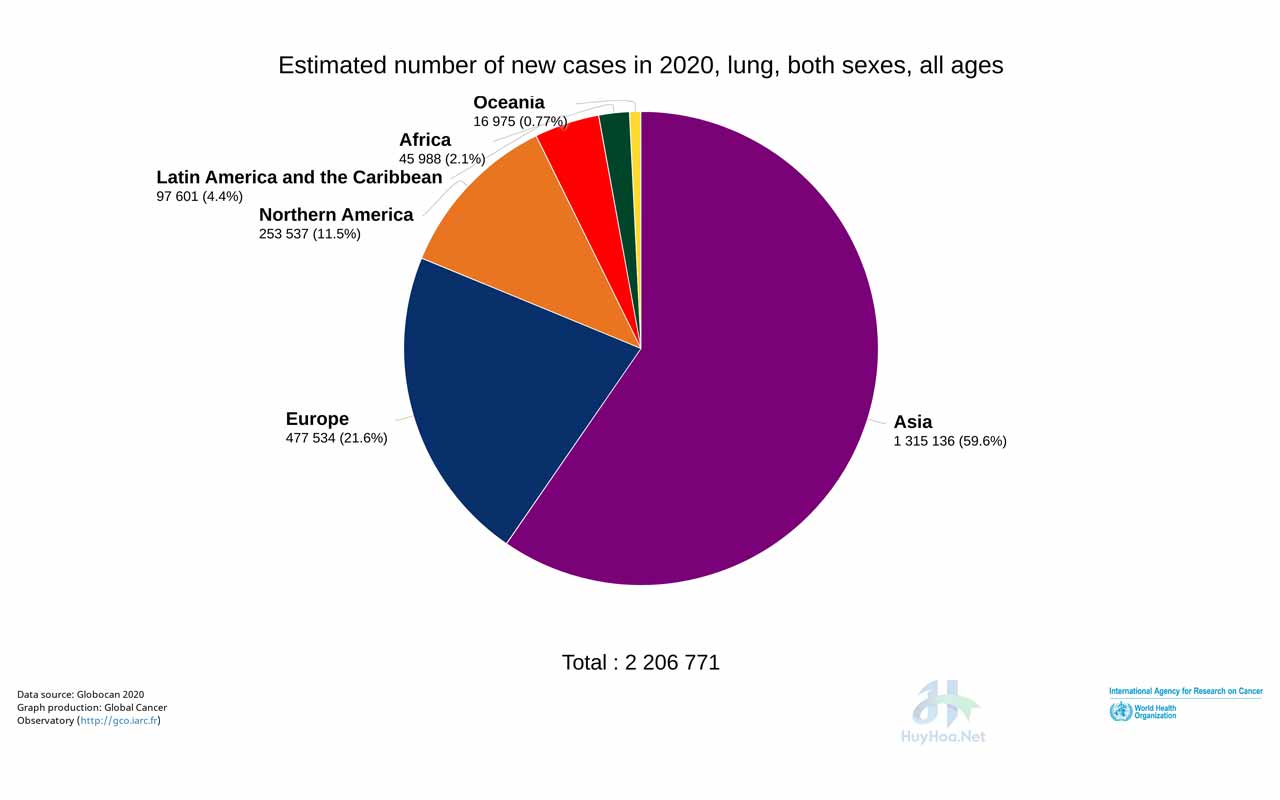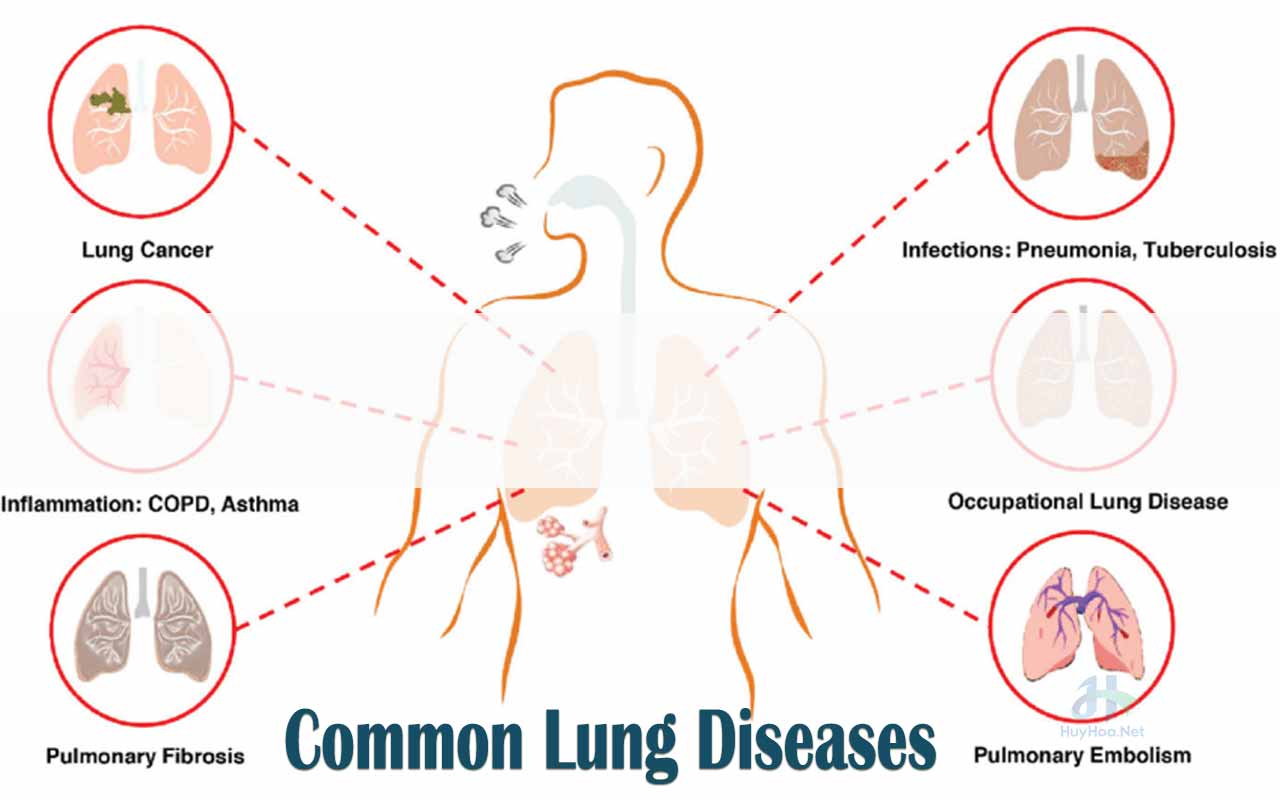Lungs are very important organs for humans, lung diseases are ranked in the top dangerous list. Along with industrial development, polluted environmental conditions, unhealthy habits are the causes of lung diseases! Let’s take a look at common lung diseases and the basic signs and symptoms to recognize early to assist in the quick treatment process, avoiding regrets from happening.

Here are the 15 Common Diseases of the Lungs that can be acquired
Table of Contents
Cold – One of the most common Lung Diseases
You can easily catch a cold from others through coughing or sneezing. A cold causes your nose to turn red, to sneeze, and sometimes to have a fever. It can also irritate your lungs and airways, triggering coughing fits, asthma, or other infections like pneumonia or bronchitis.
Usually, a cold will last for 7 to 10 days, causing you to constantly have a runny nose and sneezing. You should see your doctor if your symptoms worsen or your fever persists for 5 days or your sore throat persists.
Bronchitis
Bronchitis is a condition in which the bronchial tubes carrying air from the lungs become infected. Colds, flu, or irritants such as pollen or smoke can cause bronchitis. You may experience dry, productive coughs. See your doctor if symptoms persist for 3 weeks. If you have a fever or bloody mucus, you need to check your health immediately for timely treatment prescriptions. You can practice breathing to help treat bronchitis.
Pneumonia
Viruses, bacteria, or mold can infect the air sacs in your lungs (the sacs that hold fluid or pus). Your body temperature may rise, shortness of breath, or dry cough with phlegm. This condition is very serious, so you should see your doctor if you develop symptoms such as shortness of breath, chest pain, or a persistent fever that doesn’t go away. If bacteria is the main cause of the disease, you can use antibiotics to treat it. Other types of pneumonia can be more difficult to treat. However, you can rest and take medicine to improve your health.
Asthma
Your airways are blocked and swollen, making it difficult for you to breathe, and have a dry cough with phlegm. You can also develop allergic reactions when exposed to pollen, dust mites, or smoke. Exercise, cold air, a cold, or stress can also trigger an asthma attack. Your doctor can help you find the cause of your asthma and prescribe the right medication to help you control your breathing during an asthma attack.
Chronic Obstructive Pulmonary Disease (COPD)
This is a group of conditions that include: emphysema, chronic bronchitis, and cases of asthma that can irritate or damage the tiny air sacs in your lungs. When sick, you will feel short of breath as well as cough a lot, and cough with phlegm. You should use medication as well as change your lifestyle to help improve the condition. One of the most common triggers is tobacco. Therefore, you need to give up smoking immediately to be able to control the disease effectively.
Lung Cancer
This is one of the dangerous diseases caused by the development of malignant tumors in the bronchial epithelium. Lung cancer is one of the cancers with high malignancy of the body, treatment is still difficult today.
There are two main types of lung cancer: small cell lung cancer and non-small cell lung cancer. These diseased cells grow in tumors in the lungs. The group at high risk of getting sick is the group of people who smoke cigarettes, pipe tobacco, or are exposed to dust and smoke in the environment.
The early symptoms of lung cancer are often not obvious. You may then develop coughing spells that don’t go away as well as coughing up blood or other symptoms – chest in, wheezing, shortness of breath. Don’t worry too much, because not all of the above symptoms are caused by cancer. See your doctor for prompt treatment with therapies such as surgery, radiation, chemotherapy, or immunotherapy.
Did you know that the American Lung Association takes November every year as Lung Cancer Awareness Month?
Fast Facts
- Lung cancer is the leading cause of cancer death among both men and women in the United States.
- Each year, about 218,500 people in the United States are told they have lung cancer, and about 142,000 people die from this disease. (Source: CDC)
- Different people have different symptoms of lung cancer. Most people with lung cancer don’t have symptoms until the cancer is advanced.

Pleurisy (Inflammation of the Pleura)
Pleurisy is a condition in which the tissues lining the outside of your lungs or inside your chest become inflamed and rub together. This causes sharp pain in the chest that becomes more uncomfortable when you breathe. You may also have a cough or difficulty breathing. Viruses, bacteria, or fungi as well as certain medications, injuries, and illnesses can cause this. Treatment depends on the cause. If your illness is caused by a bacterial infection, then you can use antibiotics to treat it.
Pulmonary Embolism
A pulmonary embolism is when your body forms a blood clot, usually in your legs, which then travels to your lungs. This condition impedes blood flow and causes damage to lung tissues. At that time, you may experience respiratory symptoms as well as chest pain, cough, sometimes coughing with blood. The leg where the blood clot forms may become swollen or painful. This disease can be treated with blood thinners as well as medication or surgery.
Pulmonary Edema
Pulmonary edema is a condition in which excess fluid builds up in the air sacs in the lungs. This makes it difficult for you to breathe and feel uncomfortable when lying down. You may also experience symptoms such as a fast heartbeat, feeling suffocated, coughing up foam at the mouth, or coughing up blood.
Pulmonary Fibrosis
This disease occurs when tissues inside the lungs become abnormally thick and harden. This condition interferes with the absorption of oxygen into the blood, brain, and other organs. You may feel short of breath and have a dry cough that is hard to control. This disease is especially serious and can be life-threatening if you have had it for many years. You can ask your doctor to help you manage your symptoms effectively. Although the exact cause of the disease is not known to date, it can be due to genetics, smoking as well as infection with certain viruses.
Pneumonia
The disease is triggered when you breathe in dust, usually from asbestos, sand, stone, or coal. If your lungs absorb dust, it becomes infected and forms a scar. With this disease, you may not feel any effects for many years. But then, you may develop coughing spells, shortness of breath, or chest tightness. For treatment, your doctor will give you medication, give you oxygen, and use breathing therapy to help completely treat your symptoms and possible complications such as asthma or COPD.
Pulmonary Arterial Hypertension
This is a form of high blood pressure that affects blood vessels in the lungs and the right side of the heart. When infected, you will experience breathing problems, lightheadedness, chest pain, swollen legs, heart palpitations, or pale lips. But you may not realize these symptoms for months or even years. To treat the disease, you need to relax the blood vessels in many ways or maybe surgery.
Cystic Fibrosis
The disease occurs if you inherit a gene that causes mucus to build up in the lungs and other organs of the body. This attracts bacteria that cause constant infections, leading to lung damage and respiratory problems. Children with cystic fibrosis may be underdeveloped because mucus makes it difficult for them to absorb nutrients from food.
Respiratory Distress Syndrome
This syndrome usually develops in premature babies. This is because your baby can’t make surfactant, the liquid that helps open up the lungs. Babies with this disease often have difficulty breathing and do not have enough oxygen in their body parts. Your baby may breathe shallowly, quickly, or have redness in his nostrils. To treat this syndrome, you need to attach a breathing tube to your baby so that he can provide adequate surfactant until he can breathe normally on his own.
Sarcoidosis (Granulomatosis)
The disease starts when cells called granulomas to grow in your lungs. According to the doctor, this could be the immune system’s response to something you breathe in. When you are sick, you will have symptoms such as dry cough, shortness of breath, fever, fatigue, wheezing, or chest pain. This disease usually goes away on its own. However, your doctor can help you control your symptoms with medication and check your condition.

